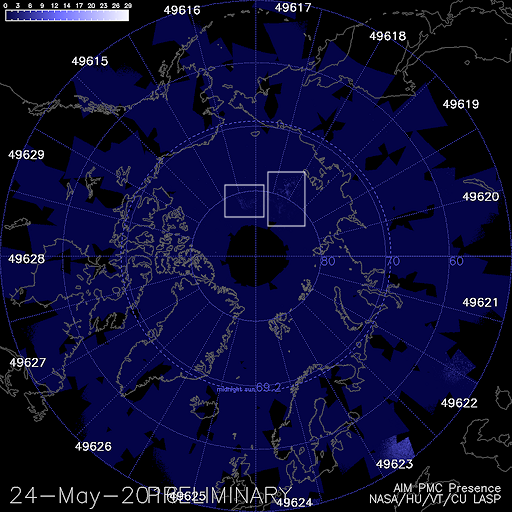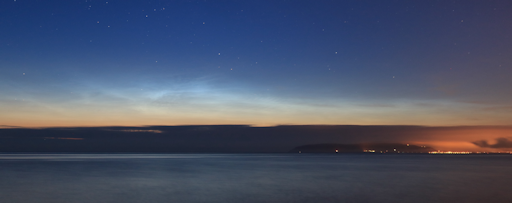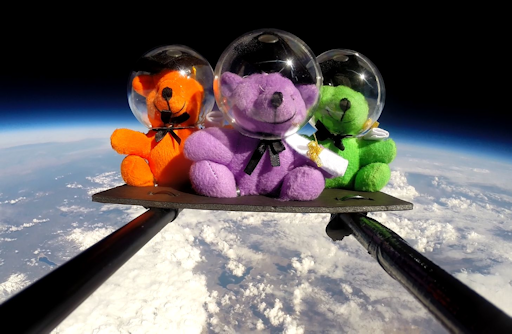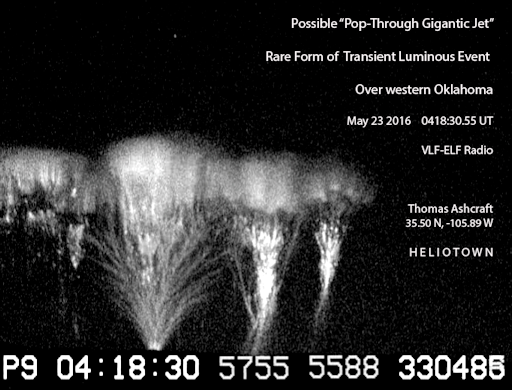It's waiting for you: The most successful Aurora Photo Tour on Earth! 100% success rate 4 years in a row and winner of the TripAdvisor Certificate of Excellence Award. Join LapplandMedia's aurora tours in Abisko, Swedish Lapland! | | |
CHANCE OF MINOR STORMS: NOAA forecasters estimate a 35% chance of minor G1-class geomagnetic storms on May 27th when Earth enters a high-speed stream of solar wind. High-latitude sky watchers should be alert for auroras, especially in the southern hemisphere where darkening autumn skies favor visibility of faint lights. Aurora alerts: text, voice.
NOCTILUCENT CLOUD SEASON BEGINS: NASA's AIM spacecraft has spotted wispy patches of electric-blue drifting over the Arctic Ocean. The sighting marks the beginning of the 2016 season for noctilucent clouds (NLCs). "The first clouds appeared on May 24th--about the same as previous years," reports Cora Randall, AIM science team member at the University of Colorado. The clouds are boxed in this polar image recorded by AIM's CIPS instrument:

These first detections from space are small and faint. They won't remain faint for long, however. Previous data from AIM have shown that NLCs are like a great "geophysical light bulb." They turn on every year in late spring, reaching almost full intensity over a period of 5 to 10 days. This means observers on the ground should soon begin to see them.
Indeed, just this morning, May 27th, Mike Griffiths of Llanfairfechan, North Wales, UK, spotted some NLCs peeking over the northern horizon:

"I saw our first NLCs of the season!" says Griffiths.
NLCs are Earth's highest clouds. Seeded by meteoroids, they float at the edge of space more than 80 km above the planet's surface. The clouds are very cold and filled with tiny ice crystals. When sunbeams hit those crystals, they glow electric-blue.
Noctilucent clouds first appeared in the 19th century after the eruption of super-volcano Krakatoa. At the time, people thought the clouds were caused by the eruption, but long after Krakatoa's ash settled, the clouds remained. In those days, NLCs were a polar phenomenon confined mainly to the Arctic. In recent years they have intensified and spread with sightings as far south as Utah and Colorado. Some researchers believe the intensification is a sign of climate change.
Early-season NLCs are always found at high-latitudes--e.g., Canada, the British isles, Siberia and Scandinavia. To people in those areas, we offer the following observing tips: Look west 30 to 60 minutes after sunset when the sun has dipped 6o to 16o below the horizon. If you see luminous blue-white tendrils spreading across the sky, you may have spotted a noctilucent cloud.
Realtime Noctilucent Cloud Photo Gallery
SPACE BEARS MAKE GOOD GRADUATION GIFTS: Around the USA, high school seniors are preparing to receive their diplomas. Nothing says "you're on your way up!" better than a graduation gift from the Edge of Space. On May 25th, the students of Earth to Sky Calculus flew a family of "graduation grizzlies" 27 km (90,000 feet) above Earth's surface:

Outfitted with space helmets and a diploma, the intrepid Ursidae survived cosmic rays, ultra-low temperatures, and the near-vacuum of the stratosphere. For $49.95 you can have one of these bears along with a unique Graduation card showing the bears floating at the top of Earth's atmosphere. Buy one now.
Sales of the bears support student space weather research. In fact, the bears pictured above were hitchhiking on a payload equipped with radiation sensors. We send the sensors to the stratosphere every week to monitor increasing levels of cosmic rays. Visit the Earth to Sky store to support this crowd-funded research.
Realtime Space Weather Photo Gallery
SPRITES (AND SOMETHING MORE) OVER OKLAHOMA: On May 23rd, an enormous swarm of sprites flickered and danced across the top of a thunderstorm in Oklahoma. Almost 400 miles away in New Mexico, amateur astronomer Thomas Ashcraft trained his cameras on the display. He captured the sprites--and something more:

"Note the dendritic upward spray in the midst of the sprite cluster," points out Ashcraft. "That is a possible 'pop-through gigantic jet'--a rare event."
Ashcraft has posted a video of the event with VLF-ELF radio emissions he recorded as a soundtrack. Turn up the volume: "The deep bass sound of the lightning stroke sounds like a distant shotgun blast in the night," he says.
What is a pop-through gigantic jet? Lightning scientist Oscar van der Velde of the Technical University of Catalonia explains: "A cluster of sprites can actually warp Earth's ionosphere, bringing it down from its usual altitude of 90 km to only 40 km." This sets the stage for the jet.
"The sprite cluster triggers an upward-directed discharge which in the past received fancy names as 'troll' or 'palm tree'," says van der Velde. "A satellite-based study by Taiwanese researchers in 2012 found them similar to gigantic jets--large isolated discharges reaching from the thundercloud toward the ionosphere. In case of a 'pop-through gigantic jet,' the lowering of the ionosphere is not uniform and the jet may then reach higher than the bottom tendrils of the sprite."
Although sprites have been seen for at least a century, most scientists did not believe they existed until after 1989 when sprites were photographed by cameras onboard the space shuttle. Now "sprite chasers" routinely photograph sprites--and more!--from their own homes. "They are easily detected by certain cameras," says van der Velde, "and if a storm is in the mood, you may record one every few minutes." Give it a try!
Realtime Sprite Photo Gallery
Realtime Aurora Photo Gallery
Realtime Comet Photo Gallery
Every night, a network of
NASA all-sky cameras scans the skies above the United States for meteoritic fireballs. Automated software maintained by NASA's Meteoroid Environment Office calculates their orbits, velocity, penetration depth in Earth's atmosphere and many other characteristics. Daily results are presented here on Spaceweather.com.
On May. 27, 2016, the network reported 13 fireballs.
(12 sporadics, 1 June mu Cassiopeiid)

In this diagram of the inner solar system, all of the fireball orbits intersect at a single point--Earth. The orbits are color-coded by velocity, from slow (red) to fast (blue). [Larger image] [movies]
Potentially Hazardous Asteroids (
PHAs) are space rocks larger than approximately 100m that can come closer to Earth than 0.05 AU. None of the known PHAs is on a collision course with our planet, although astronomers are finding
new ones all the time.
On May 27, 2016 there were 1701 potentially hazardous asteroids.
Notes: LD means "Lunar Distance." 1 LD = 384,401 km, the distance between Earth and the Moon. 1 LD also equals 0.00256 AU. MAG is the visual magnitude of the asteroid on the date of closest approach. | | Cosmic Rays in the Atmosphere |
| Situation Report -- Oct. 30, 2015 | Stratospheric Radiation (+37o N) |
| Cosmic ray levels are elevated (+6.1% above the Space Age median). The trend is flat. Cosmic ray levels have increased +0% in the past month. |
| Sept. 06: 4.14 uSv/hr (414 uRad/hr) |
| Sept. 12: 4.09 uSv/hr (409 uRad/hr) |
| Sept. 23: 4.12 uSv/hr (412 uRad/hr) |
| Sept. 25: 4.16 uSv/hr (416 uRad/hr) |
| Sept. 27: 4.13 uSv/hr (413 uRad/hr) |
| Oct. 11: 4.02 uSv/hr (402 uRad/hr) |
| Oct. 22: 4.11 uSv/hr (411 uRad/hr) |
These measurements are based on regular space weather balloon flights: learn more. Approximately once a week, Spaceweather.com and the students of Earth to Sky Calculus fly "space weather balloons" to the stratosphere over California. These balloons are equipped with radiation sensors that detect cosmic rays, a surprisingly "down to Earth" form of space weather. Cosmic rays can seed clouds, trigger lightning, and penetrate commercial airplanes. Our measurements show that someone flying back and forth across the continental USA, just once, can absorb as much ionizing radiation as 2 to 5 dental X-rays. For example, here is the data from a flight on Oct. 22, 2015:

Radiation levels peak at the entrance to the stratosphere in a broad region called the "Pfotzer Maximum." This peak is named after physicist George Pfotzer who discovered it using balloons and Geiger tubes in the 1930s. Radiation levels there are more than 80x sea level.
Note that the bottom of the Pfotzer Maximim is near 55,000 ft. This means that some high-flying aircraft are not far from the zone of maximum radiation. Indeed, according to the Oct 22th measurements, a plane flying at 45,000 feet is exposed to 2.79 uSv/hr. At that rate, a passenger would absorb about one dental X-ray's worth of radiation in about 5 hours.
The radiation sensors onboard our helium balloons detect X-rays and gamma-rays in the energy range 10 keV to 20 MeV. These energies span the range of medical X-ray machines and airport security scanners.
| | The official U.S. government space weather bureau |
| | The first place to look for information about sundogs, pillars, rainbows and related phenomena. |
| | Researchers call it a "Hubble for the sun." SDO is the most advanced solar observatory ever. |
| | 3D views of the sun from NASA's Solar and Terrestrial Relations Observatory |
| | Realtime and archival images of the Sun from SOHO. |
| | from the NOAA Space Environment Center |
| | the underlying science of space weather |
 | Claim your tax refund with this UK tax rebate company and get back your overpaid tax. |
 | Enjoy this fabulous range of leather sofas from a leader in the UK sofa manufacturer industry.. |

